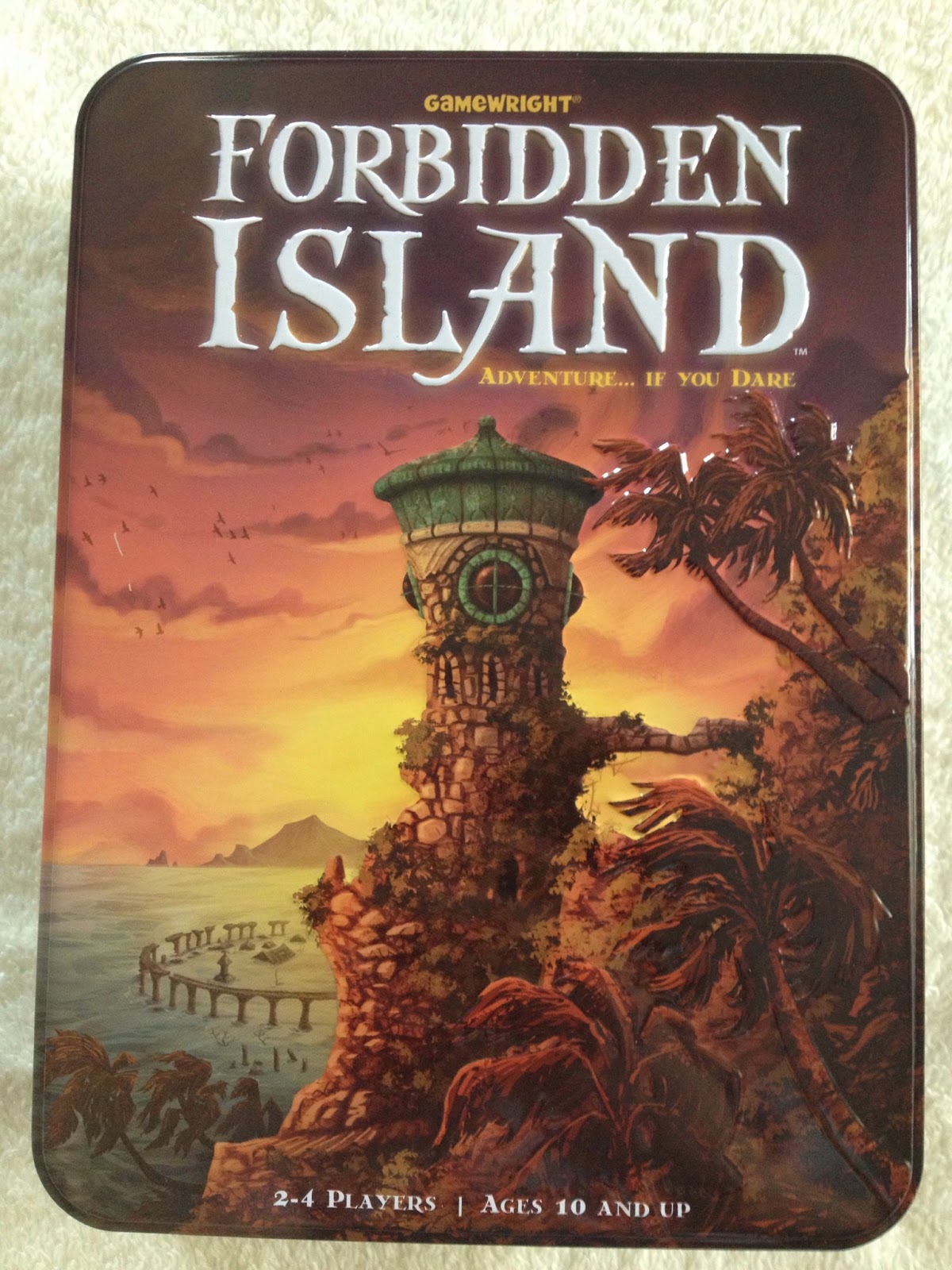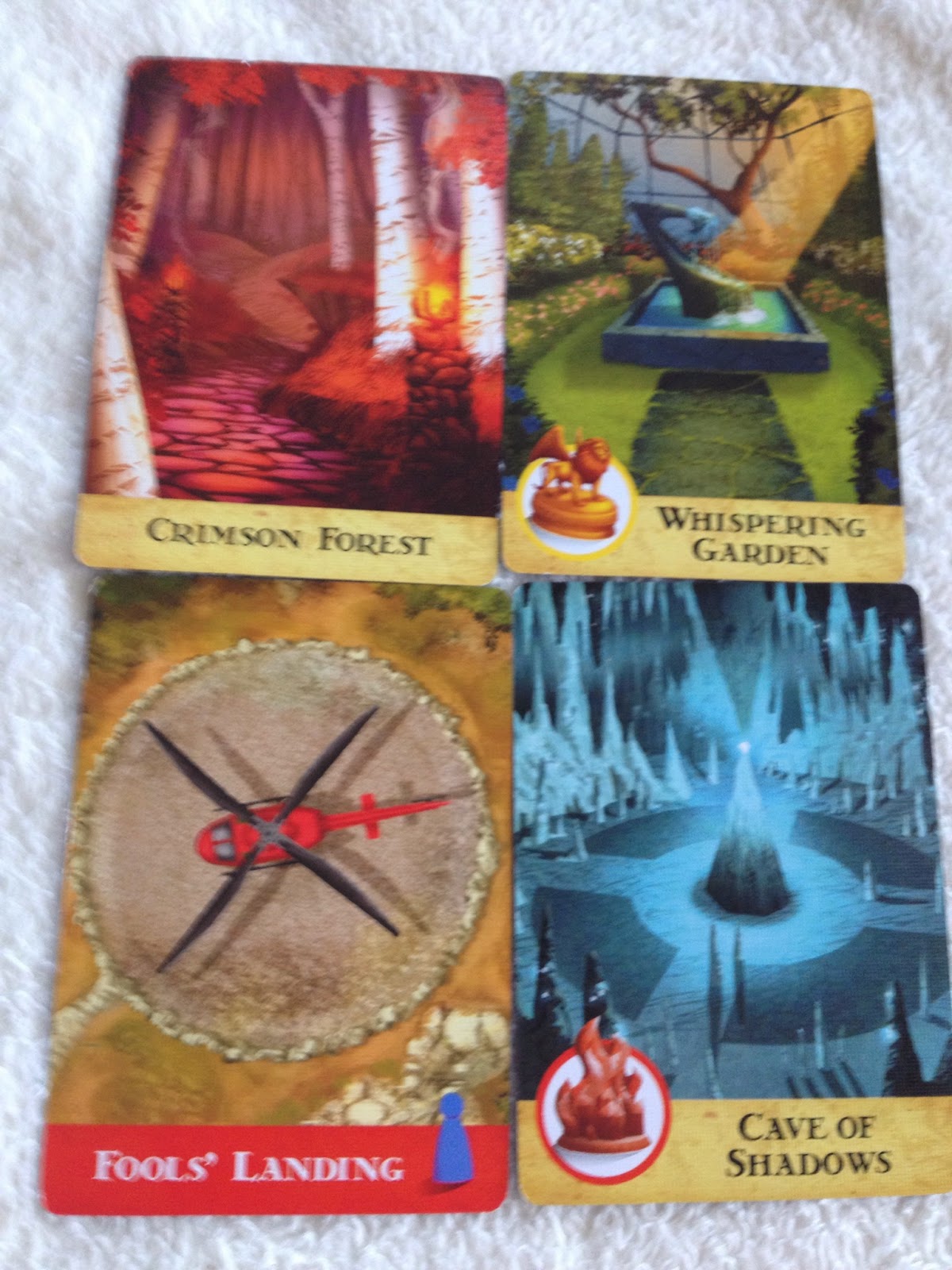Game Overview
I started playing this game about six months ago with my gaming group. It plays in a similar manner to the game Pandemic (which makes sense because it comes from the same designer-Matt Leacock).
Basically, you and up to three friends are on a treasure hunt and you have been dropped off in the middle of the ocean on a mysterious sinking island and although you are in danger of sinking with the island, you refuse to leave until you have obtained all four of the island's treasures.
Rules Summary
This is a cooperative board game in which the players team up against the island. To begin, the island tiles are laid out randomly (see example above). The tiles to pay attention to are Fool's Landing (helicopter pad) and the eight containing treasure icons. These tiles need to remain afloat for much of the game (discuss in more detail later).
Along with the tiles, there are three sets of cards - role cards, island cards, and treasure cards. Each player is assigned a role card which explains their special ability and determines their starting space on the board. They also get 2 treasure cards to begin the game.
To set up the board, follow the picture above. The island gets the first turn, six cards are drawn from the island card stack. Each card matches one tile (area on the island). The tile that is drawn indicates that area on the island has been flooded and to represent the flooding, that tile must be flipped over to its blue (flooded side). If the same card comes up again while the tile is flooded, the tile and its corresponding card are removed from the game and lost forever.
Each adventurer then takes their turn which consists of taking three of any combination of the following actions:
- The player can move one space up, down, left or right (the player whose role is explorer has the power to also move diagonally).
- Shore up a tile by flipping it back over and thereby unflooding it.
- Give another player a treasure card from your hand.
- Capture treasure. To capture a treasure you must discard four identical treasure cards while being on that matching treasure tile.
Then it is the island's turn again and the bad stuff starts to happen. Two, three, four or five cards are drawn from the island deck depending on the water level (water rises depending on how many water cards have been drawn during the gam - see water level indicator below).
The game continues until the players win by collecting all four treasures and returning to the Fool's Landing tile and then using a helicopter lift card OR....more likely.....the island wins by sinking a necessary tile or a player drowns, or the water level reaches the skull and crossbones symbol.
Components
This game comes in a very attractive tin, not a box. I really like this because it travels very easily and it is easy to open and close (I find that some cardboard game boxes fit together so well that is can be a small struggle to open them). I understand some people may not like this because it may not stack well, however, this is not a problem for me and I think simply putting it on top of a stack of cardboard games or sliding it in a book shelf will solve the problem anyway. I am a fan.
The insert inside the tin fits everything perfectly and the cards and tiles are easy to remove. The instruction manual and water level marker set on top of this insert.
This is an overview of what the starting tile/island setup look likes. Because these tiles are places randomly, the island is different every time you visit which keeps the game fresh.
Once an island card is drawn, the corresponding island tile is flipped over to its blue side which indicates that it is flooded. The tile can be used normally but it is in danger of sinking and being lost forever. The image on the back is identical to the front except it is in bluescale. This is a simple and effective design.
These are island cards and each card matches a tile on the game board. On each island turn, 2, 3, 4, or 5 cards are drawn (depending on the current water level). I think it is really cool that these cards exactly match the tiles and I like the artwork quite a bit.
These cards are mixed into the treasure deck (see below) and can be lifesavers.
These are the treasure cards that each player collects in order to retrieve the island's treasure. The backs of these cards are different from the island cards which is really great because it makes it impossible to mix them up. These cards are simple and pleasing to look at. My only complaint is that I don't quite get how the cards fit thematically into the game. I imagine them to be clues to solve puzzles blocking the treasures but this is not stated anywhere.
This card is pure bad news! ...And it always come up at the worst time possible, without fail. I like the detailed instructions printed on the card. These, and the instructions on the back of the role cards keep you from having to look up very much stuff in the manual which I really appreciate.
If you play a game of Forbidden Island, it is very easy to get mad at this thing. The red marker indicates how many island cards you must draw during the island's turn and it increases every time you draw a water's rise card from the treasure deck. This is also where you select your starting difficulty (there are four increasingly difficult levels to keep challenging you as you get better at the game). It is made of cardboard and is very sturdy. The slider fits perfectly, it is easy to slide and stays snug (I wish Betrayal at House on the Hill would use something more like this). Also, the slider does not scratch the indicator during use which is what I was worried about. I like the look of it a lot and it is simple and easy to read.
These are the treasures the players hunt for. These pieces are good quality, detailed, and are a really nice size. It is fun to collect these and have them sit next to you for the rest of the game. The rule book has names for these treasures but my game group has affectionately renamed them: Rock of Power, The Holy Grail, Fire of Ages, and Gryffindor.
The pawns are simple but effective. I would have preferred them to be slightly larger but they are certainly adequate.
This game is very fun and easy to teach which makes it a gateway game for newbies. In fact, this is one of the few games I can get my mother to play which says a lot. It is pretty inexpensive (currently about $16 on Amazon). The rules are simple and the graphics are nice. This is one of those games where losing can be just as fun as winning. Players must really discuss and plan well in order to stay ahead of the island which becomes increasingly difficult as the island gets smaller and smaller and the number of island cards gets higher and higher. Overall, a great light game that I highly recommend.
Positives
- Random board layout makes every game different
- Option to change difficulty
- Easy to teach due to cooperative nature of game
- Getting the right cards to the right players can be difficult
- A lot of turns have to be spent “babysitting” important tiles
- Having to hold on to a helicopter lift card to win the game is annoying because there are lots of times you want use it and because of the hand limit
How this game made it to my collection
Forbidden Island just appeared on my doorstep one day in December as if it was a copy of Jumanji. I had recently ordered a game from Amazon and when this came instead, I naturally assumed there was a mix-up. I convinced Amazon (even though the package was from Gamewright) that they must have shipped the wrong game and we made arrangements to exchange the game. Before I could send it back, the game I actually ordered arrived. I was very confused until a few days went by and I found out that it was actually a gift from my aunt for Christmas. I am so glad I didn't send it back to Amazon because I have really enjoyed playing this game.














No comments:
Post a Comment